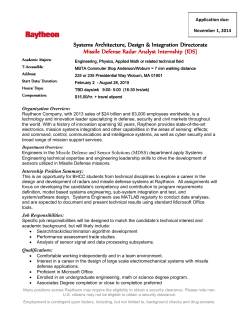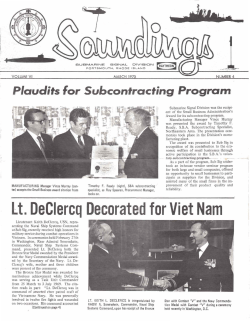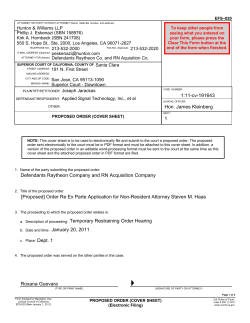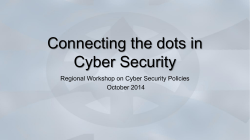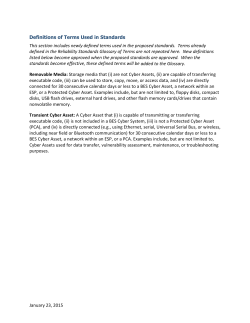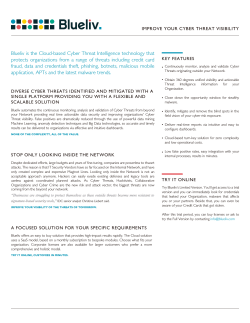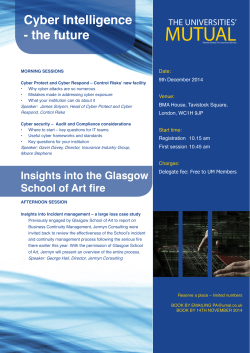
Intelligence Software
UKnews A RAYTHEON UK PUBLICATION WINTER 2014/2015 SPOTLIGHT ON: INTELLIGENCE SOFTWARE IN THIS ISSUE: SME INVESTMENT INTELLIGENCE ANALYSIS EVENTS PRODUCT UPDATES NEWS IN BRIEF Raytheon Establishes UK Cyber Innovation Centre Message from the Chief Executive In this edition of our stakeholder newsletter, I would like to reflect on some of the highlights of 2014 which I would characterise as four key things: investment in technology and skills, a strong focus on our customers, robust operational performance and expansion into new markets. Earlier in the year, as part of our strategy, the new Intelligence and Security business was formed through merging the National Security and Defence Intelligence business areas, in order to better utilise our considerable and often complementary cyber and intelligence expertise. To facilitate growth into new markets, Raytheon Company has made a significant investment in our cyber capability in the UK with the establishment of a new facility in Gloucester which will grow in size to house around 100 cyber professionals. The retention of Sentinel and Shadow, announced at the Farnborough Air Show, is being supported by infrastructure enhancements at Waddington and Broughton where Welsh Government investment and our own growth commitment will increase the number of jobs by more than 50 per cent. The transition of Raytheon UK’s manufacturing capability to Glenrothes has enabled us to put in place a growth and manufacturing excellence initiative, which aims to make it a world-class facility. The investment we made in Silicon Carbide technology will in future reduce fuel burn on commercial aircraft and has recently seen a contract award from a major automotive manufacturer for the development of devices for electric and hybrid vehicles. Inspiring the next generation of engineers has been an area of particular focus for our Innovation Champions Network, who spearheaded the company’s STEM engagement at the Farnborough, RIAT and Waddington airshows, as well the Cheltenham Science Festival. At Raytheon UK we are focused on delivering Growth Through Collaboration which means cohesion, sharing of knowledge, creating long-term value and working together. Thank you for following Raytheon UK and I look forward to a mutually successful 2015. Richard Daniel Chief Executive, Raytheon UK 2 UKnews - Winter 2014/2015 Raytheon Company has created a Cyber Innovation Centre (CIC) in the South West of England, broadening its network of global cybersecurity research capability and leveraging its decades of expertise in detecting complex cyber threats for both governmental and commercial customers. The Centre will operate as a research, development and innovation hub for intelligence and security, housing more than 100 cyber specialists. Richard Daniel, Chief Executive Officer of Raytheon UK, said: “Our end-to-end cyber capabilities include cyber defence solutions to address insider threats, counter intelligence, data analystics and secure information sharing. Raytheon’s CIC will partner with domain experts, academia and prime contractors to provide leading software development and vulnerability research services to help customers become resilient and operate with confidence in cyber space.” Raytheon UK Broughton Expansion To Create 50 New Jobs Raytheon UK is to expand its existing facility in Broughton in a move that would create up to 50 jobs in Wales within programme and operational management, engineering and quality, logistics and commercial disciplines. The site, already renown for its leading expertise in aircraft modification for Intelligence, Surveillance and Reconnaissance (ISR) as well as the Sentinel and Shadow fleets, will be positioned as a Centre of Excellence for design and programme management for domestic and international customers. Richard Daniel, Raytheon UK’s Chief Executive Officer, said that the new facility would “enable Raytheon to address burgeoning international and adjacent markets with new customers, such as border control authorities and civil contingencies agencies.” The investment will also include technology R&D and apprentice/graduate roles to foster future aerospace leadership talent. RTN UK Chairman Receives Honorary Degree Raytheon UK’s Chairman Ian Stopps CBE (right) received an Honorary Doctorate of Technology from Loughborough University in recognition of his outstanding contribution to the UK aerospace, defence and security sectors. Ian attained a first-class degree in Mechanical Engineering from Loughborough in 1969. He has since enjoyed a distinguished career within the aerospace and defence industries in both the UK and US for which he was recognised with a Commander of the Order of the British Empire (CBE) award in the 2003 Queen’s Birthday Honours. Ian currently serves as Chair on the School of Business and Economics’ Strategic Advisory Board of Loughborough University. TECH UPDATE TECH INNOVATION PRODUCT MILESTONES Paveway™ IV Maiden Flight On JSF Raytheon UK To Develop SiC MOSFETs for Automatives A leading automotive manufacturer has selected Raytheon UK’s acclaimed semiconductor business unit to develop a Silicon Carbide (SiC)-based Metal Oxide Semiconductor Field Effect Transistor (MOSFET) for use in electric, hybrid-electric and plug-in hybrid electric vehicles. An established fabricator of semiconductor devices for automative power and control applications, Raytheon is Europe’s only SiC production foundry. SiC‘s high-temperature operation, low switching losses and low parasitics, make it possible to produce reliable, high-power devices in small and light-weight packages. Age of Science: Raytheon’s Tomahawk Missile Flexes Its Muscle At London Museum Electronics Unit for the weapon is manufactured at Raytheon UK’s facility in Glenrothes, Scotland. A full-scale Raytheon Tomahawk Block IV precision cruise missile was installed in October at the London Science Museum’s Information Age gallery. Deployed by the UK Royal Navy and U.S. Navy, Tomahawk’s two-way satellite data link enables strike controllers to flex it in flight to address pre-programmed alternate targets, or redirect it to an entirely new target. Upgrades are currently underway which include a new seeker that would enable Tomahawk to strike moving targets on land and at sea. Improvements to the missile’s warhead and communications suite are also planned. It is the only aerospace and defence product of its kind to be featured in the gallery which highlights GPS as one of mankind’s most significant technological advancements. GPS technology is vital to the operational effectiveness of Tomahawk and the sophisticated Guidance Raytheon UK’s Paveway™ IV made its first trial flight on the F-35 Lightning II (JSF) aircraft on 13 November, the first in a series being run to clear the UK Ministry of Defence’s weapon configuration for Initial Operating Capability. This initial Paveway™ IV/F-35 integration programme Flutter trial aimed to measure the aircraft’s structural response with weapons mounted on its wing stations. The weapons configuration consisted of four wingmounted Paveway™ IV and two ASRAAM missiles, however the JSF will ultimately be cleared for a six Paveway™ fit with the addition of two weapons in the aircraft bomb bay. The achievement of this first flight follows seven years of collaboration with BAE Systems and represents a significant Raytheon milestone. CORPORATE PARTNER SCHEME RTN UK Becomes IET Corporate Partner Raytheon UK has been formally recognised as an Institute of Engineering Technology (IET) Corporate Partner. The company’s signing to the invitation-only Corporate Partner scheme demonstrates its high level of commitment to professional recognition and continuous professional development. John Gallagher, acting director of Engineering and Quality Assurance for Raytheon UK, said: “This recognition supports Raytheon’s vision to be the most admired defence and aerospace systems company through world-class people, innovation and technology. “ Winter 2014/2015 - UKnews 3 COVER STORY: ISR GAME ON: RAVEN In highly complex warfighting scenarios, where enhanced situational awareness and actionable intelligence is key, Raytheon’s smart, new, innovative Intelligence, Surveillance and Reconnaissance (ISR) analysis system, Raven, will be a game changer in the global intelligence market. We’ve all seen this sort of scenario play out in recent times: A NATO nation is being sucked into a crisis where infrastructure is limited. The media is reporting real-time on a worsening situation and the nation has to react faster and faster every time. Expeditionary forces are en-route. The immediate call is for intelligence and for situational awareness from all available sources. Deployment on this sort of mission always starts small and needs to happen quickly. Let’s assume a small team of specialists deploy in an unobtrusive way and need eyes, ears and analysis capability that they can carry. Sensors, aircraft, UAV’s and an existing intelligence database all need to be used and are only the first part of the picture. Users need the ability to exploit the different types of intelligence both 4 UKnews - Winter 2014/2015 back on home soil and in harm’s way. Importantly, that intelligence must be coherent between all users. With contemporary capabilities, the ‘container city’ would be required to provide servers, storage, networks and thick client applications that are hungry for computer processing power. These are slow to build and are high profile. Additionally, they require multiple analysts to fuse together intelligence from multiple sources. Unveiled at the company’s annual Technology Conference in November, Raven is an innovative, highly interoperable ISR search, visualisation and analysis platform designed to exploit sensor intelligence and big data access for realtime decision requirements in fast-paced, operational environments. COVER STORY: ISR Affordable Solution A Flexible and Agile Tool For Challenging Environments In our scenario, a small intelligence team is sent but now equipped with Raven they would have access to easy ISR exploitation and interoperability on a single laptop. Optimised for deployed users facing unique challenges on operations, Raven’s intuitive, lightweight software solution provides intelligence analysts with an easy-to-use interface. The software enables complex search for enhanced situational awareness and immediate exploitation of ISR data from image, intercept and other intelligence products. Raytheon UK’s Head of Information Exploitation Mark Lavis-Jones says: “Deployed analysts cannot be reliant upon huge fixed infrastructures and we have identified a real end-user need for an interoperable capability, served from a single laptop, aimed at the deployed domain, for those we describe as ‘disadvantaged’ users with limited bandwidth.” Derived from affordable, open source and COTS software, Raven incorporates metadata from available intelligence products, allowing the remote user to access various intelligence payloads when required. A built-in enterprise service bus allows integration of different exploitation toolsets to enhance user requirement preferences and facilitate interoperability with allied and coalition partner data sets. “Raven has been designed to require little training,” says Lavis-Jones. “We have incorporated the new generation of software that users will be used to seeing on social media platforms enabling them to easily and intuitively use familiar search techniques and tools. For example, a customer may use our collaboration tool to share different layers of data and intelligence with their community of interest, including full motion video and high military resolution 3D imagery.” “Raven is a demonstrable example of Raytheon UK’s innovative approach to collective enterprise in the ISR domain,” said CEO Richard Daniel. “As a proven ISR prime systems integrator, we were able to identify and integrate a number niche exploitation toolsets from Small and Medium Enterprise (SME) contractors to leverage the Raven solution.” Unique Offering Lavis-Jones added: “Over the past 12-18 months we have been researching and developing this capability, surpassing our original design aims. We’ve had to find toolsets that perform functions with a fraction of the computer processing power that big contemporary software solutions require.” Developed in the UK and designed to be fully exportable and flexible, in that the tools, portal and connectors, for example, can be changed or tailored according to the customer’s particular needs, Raven is a unique offering in the evolving global intelligence market. � RAVEN CORE • Intuitive user experience delivered through a fully customisable and adaptable browser-based social portal • Highly interoperable, multi-data type environment with NATO Standard Coalition Shared Databases, Structured Query Language and video data storage • Raven is also interoperable with Overseer, a new Airborne Mission Management Solution developed by Raytheon UK. Overseer combines intuitive user interfaces with a modular and flexible design to deliver a mission management system at the cutting edge, not only in terms of its software, architecture and open standards implementation, but also its usability, trainability and maintainability – all critical elements to Raytheon customers around the world. High speed, full text, geo-spatially aware enterprise search across all data sets and stores • For Raytheon, the future of ISR airborne solutions is very much towards multi-mission platform capability. That is, platforms that are not dedicated to single sensors or single capabilities, but those which overlay intelligence from multiple sensors, bringing a broader range of capabilities together in order to give the commander a more comprehensive view. Full 2D and 3D visualisation, situational awareness and data fusion across result sets and industry standard geospatial and topographical reference data • Phil Nettleship, Chief Engineer of Airborne Solutions business, Raytheon UK says: “At the heart of all our aircraft programmes, including Shadow R1 and Sentinel R1, is an airborne mission management system. “Over the past two years, we have spent a lot of internal resource and investment exploring what that mission management system needs to look like for the future to enable a multi-mission capability that allows us to plug in new sensors when they come online, remove them or upgrade them. And to do this without having to upgrade the entire platform.” Configurable business workflows incorporating Request for Information and Resource Task management, notification, allocation and completion functions based on clearly defined enterprise procedures • A full Service Oriented Architecture interoperability platform, deployable on disconnected laptops through to enterprise scale environments OVERSEER Winter 2014/2015 - UKnews 5 NEWS FEATURE: TECHNOLOGY CONFERENCE INNOVATION: CREATING GATEWAYS TO GROWTH Cyber Security and C4ISR were the two hot topics up for debate at Raytheon UK’s annual Technology Conference, held 27 November at London’s Park Plaza Hotel in Westminister. With cyber-related news repeatedly hitting national headlines and the government’s Strategic Defence and Security Review (SDSR) 2015 on the horizon, the discourse on Cyber Security and C4ISR themed throughout Raytheon UK’s annual Technology Conference proved timely, relevant and often passionate. The overarching view was that more backing was needed for the defence sector, but that winning public and government support during an array of spending cuts and an upcoming general election would again be an uphill struggle. Tactics, such as whether each of the forces should work more closely together and efficiently, were discussed throughout the day. Growth Strategy Raytheon UK’s Chief Executive Officer Richard Daniel stressed the importance of the UK business to Raytheon: “It is part of the Raytheon Company ethos to continuously drive growth strategy.” Daniel also emphasised Raytheon UK’s role in adding value to the economy – by creating jobs and nurturing skills, generating intellectual property and delivering operational capability. 6 UKnews - Winter 2014/2015 As part of that growth agenda, he revealed Raytheon’s investment in creating Raytheon UK’s first Cyber Innovation Centre which is located in Gloucester, England. The Centre will formally open in early 2015 and will have its own cyber test and development facilities serving multiple customers. “The UK is far from ignoring the increasing, ever-evolving threat from cyber-attacks, which are for a multitude of reasons, and our growth in Gloucester will help provide focus to many companies’ efforts in this domain,” Daniel said. Defence industry analyst Howard Wheeldon, who delivered the opening speech, echoed Richard’s views: “Raytheon is no small player in the UK and its presence here is extremely important. This is technology at its best and it represents the continuation of high levels of investment by the company in UK sovereign capability.” Wheeldon highlighted that while some believe growing activities among defence companies may be considered areas for “boffins” and appear to have no place in people’s everyday lives, they would be wrong. He said, “cyber security is now of such critical importance that, unless we better recognise the dangers and get our act together, we really could see the impact of what a cyber-attack can do in destroying what we all take for granted.” NEWS FEATURE: TECHNOLOGY CONFERENCE Critical: ISR and Cyber Throughout the day, Raytheon UK business divisions each took the opportunity to provide the guests from academia, industry, government, SMEs, think tanks and the media with insights into their current and future innovations. The two panel discussions, entitled ‘C4ISR’ and ‘Creating a Cyber Eco-System’ sparked particularly stimulating debates. C4ISR guest panellists included: industry analysts Howard Wheeldon and Paul Beaver; Professor Philip Davies, director at Brunel Centre for Intelligence & Security Studies; John Craib, business development executive at Raytheon UK; and Air Vice-Marshall Nigel Maddox, an advisor at UKTI. Wheeldon stressed: “Nothing that the Royal Air Force did in Iraq, in Libya, in Afghanistan was done in isolation. In a world of accountability and where risks today must usually be signed off by a responsible officer, military mission success can only ever be achieved if and when it is accompanied by good air, sea and battlefield management. For that to occur requires the best in intelligence, surveillance and reconnaissance.” The importance of Intelligence, Surveillance & Reconnaissance (ISR) was emphasised – from satellite images to human intelligence – in order to ensure that informed decisions can be made and to significantly increase the chances of operational success. More importantly, interoperable capabilities such as Raven (Raytheon UK’s new ISR analysis software solution – See Cover Story on page 4-5 ), which was launched and demonstrated during the Conference, are strategically and tactically imperative to allies, in order to align their decision-making process more efficiently. In turn, Air Vice-Marshall Nigel Maddox explained the importance of targeting high-value contract opportunities to bolster the £13 billion of new business generated across the Defence sector in 2013 alone. There are 150,000 technical people employed in the defence industry and a further 150,000 in the supply chain. “I can assure you this administration is very aware of what Raytheon and other companies invest in the UK and how we can assist them to export,” said Maddox. He highlighted that if companies such as Raytheon UK, which have foreign parents, are not in direct competition with UK firms then it would be misguided not to support them. While few are expecting many surprises from the forthcoming SDSR, Maddox believes that the growing influence of exports will determine how budgets will be allocated domestically. He also noted that when doing business with the Middle East, South America and Far East, the importance of recognising the culture and having a presence cannot be underestimated. Creating a Cyber Eco-System The afternoon panel discussion on Creating a Cyber Eco-System was chaired by Nick Watts, a policy advisor and cyber-security policy consultant. The premise of such an eco-system would see academia, customers, government and industry working in unison to recognise emerging threats and address these with the latest solutions. The afternoon panel included: Dr Dan Prince from Lancaster University; Nigel Harrison, executive director of Business Engagement at Cyber Security Challenge; Graham Le Fevre, head of Cyber at Raytheon UK; and Nettitude’s CEO, Rowland Johnson. Watts outlined that the government has set its eyes on the UK becoming the most digital economy, which should save British taxpayers £1.7 billion over coming years and added that the cyber world is also ripe with opportunities. Johnson quoted from a cyber survey that ranked the UK cyber capability at number one, and ranked it fourth or fifth for market opportunities. At the same time, Le Fevre explained that Raytheon has been keen to enter the cyber domain for some time and last year it realised it had to adopt a different approach, effectively creating a cyber eco-system to meet customer needs. Dr Prince said Lancaster University’s MSc in Cyber Security is setting the bar for a pipeline of new talent. The degree course is certified by GCHQ (Government Communication Headquarters) and its focus is on producing the next generation of multi-disciplined, high-calibre employees. On the course, students also take modules in politics, law, psychology and business beyond their core technical units. However, Mr Harrison reminded the audience that with the sector still in its infancy there’s still a need to discover and mentor hidden talent, which Raytheon UK and the Cyber Security Challenge are striving to do. � Thought Leadership in Motion: The overarching view of the panel and speakers was that more backing is needed for the defence sector. Winter 2014/2015 - UKnews 7 SME PARTNERSHIPS HARNESSING SME INNOVATION Earlier in 2014, Raytheon launched its second SpaRk (SME Partnerships Advancing Raytheon Knowledge) research and development competition as part of its growth strategy to foster innovation through collaborative relationships with UK small to medium-sized enterprises (SMEs). Driving growth through harnessing internal and external innovation, and engaging with SMEs, academia and the supply chain, was one part of Raytheon UK’s continued strategy in 2014. Collaborating for Growth: Raytheon UK CEO Richard Daniel chats with industry analyst Paul Beaver during the Technology Conference networking session. In November, the company announced the winners of its SpaRk research and development competition as specialist engineering businesses Plextek and MASS, along with the University of Nottingham. As part of the prize, each organisation receives a grant of up to £50,000 to undertake a technological research project aligned with Raytheon UK’s principle business areas. “SMEs and academia are key to extending Raytheon UK’s research and development (R&D) supply chain,” said Richard Daniel, chief executive of Raytheon UK. “We believe that building collaborative R&D relationships with this community will enable us to deliver 8 UKnews - Winter 2014/2015 innovative solutions that meet the evolving needs of our customers across defence, power electronics and intelligence and security markets. In exchange they will gain access to challenging markets, paths to exploitation and relationships with primes, which include guidance and networking.” Defence (Navigation) - Plextek Plextek Consulting, a leading provider of technology innovation and technical engineering in the defence, medical and automotive markets, addressed the need for a technology to provide dismounted soldiers with a reliable estimate of their position in a GPS-denied environment – for example, it would enable a soldier to navigate around a building when a GPS signal is unavailable. SME PARTNERSHIPS The company’s concept of ‘network enhanced, GPS-denied navigation’ promises to deliver a low SWaP (Size, Weight and Power), hard to deny, easy-to-adopt solution that involves integrating inertial sensors within soldiers’ boots. The inertial sensors within a group of dismounted soldiers are able to communicate and share information with each other, improving the overall positional accuracy for each soldier. Focusing on the end-result and suggesting an exploitation route to where Raytheon could take the product, was a key driver in terms of the decision to select Plextek as the winner of the ‘SpaRk Defence’ competition. In fact, Raytheon identified a very strong correlation between the type of technology Plextek was presenting and Raytheon’s GPSAnti Jam product area, specifically in relation to position, navigation and time. Cyber - MASS The world is continually under attack from cyber criminals. Raytheon UK set a challenging and specific scope for the ‘SpaRk cyber competition in terms of investigating the tools and platforms required to help reverse engineers to identify vulnerabilities within software. MASS, a specialist in designing, integrating and supporting information systems for the defence, information assurance, security and education markets, presented Raytheon UK with a compelling proposition in their approach to finding a cyber solution. By taking some of the best aspects of MASS systems and software engineering capability and partnering with the University of Kent to leverage academic expertise, it was able to bring together the four components the company cites as necessary for innovation: engineering, science academia, the end-user (reverse engineers) and project managers. MASS and Kent University, leaders in the field of reverse engineering code, proposed an interactive toolset approach to help answer questions more effectively about path feasibility, as part of analysing software vulnerabilities with greater accuracy and speed. The approach utilises intermediary languages and the integration of SMT solvers into IDA Pro as a plug-in. Such translation of binary code into a useful format is a timeconsuming task and Raytheon UK and MASS intend this enhanced toolset to aid and improve productivity. Power & Control - Integrated Power System Raytheon UK sought expertise to help it in the area of common power modules, which has a great market potential going forward in terms of More Electric Aircraft (MEA), UAVs, etc. The University of Nottingham brought its world-class research and development knowledge of power products to resolve the particular problem. The design challenge was to create a flexible solution that could be used across different applications, in varying operating modes, with minimum variations in terms of hardware and software. The converter had to be modular to provide the adaptability to expand the power of the system by simply plugging together a higher number of modules. The final requirement was high volume density (i.e. minimum volume and minimum mass), together with high efficiency and heat management. The University’s proposed research project is aimed at providing a full design package for a common power module. The initial phase will demonstrate the feasibility of the project, examining topology, thermal management and control aspects of a common power module and set a basis for potential future developments. The technology will be progressively developed and pushed toward its limits with relevant experimental validation being the final output of a long-term collaboration. Future Exploitation Future modern warfare will present an increasingly challenging battleground and Raytheon UK agrees that bringing thought leaders in academia together with agile SMEs to work with big primes such as itself who can leverage into national and international markets, will ensure ongoing success. � Winter 2014/2015 - UKnews 9 SMALL DIAMETER BOMB II TODAY’S FORECAST: BULLSEYE. Whether threats stand and fight, or run and hide, Raytheon’s Small Diameter Bomb II is the next-generation capability for all weather conditions. Available today as an integral capability on F-35B, SDB II can prosecute moving and fixed targets quickly, accurately and efficiently. With Raytheon’s proven record on Paveway, AMRAAM and Tomahawk, the SDB II may be small in size but it’s huge in demonstrated results. See how SDBII is changing the game at: Raytheon.com | Keyword: SDBII Connect with us: © 2014 Raytheon Company. All rights reserved. “Customer Success Is Our Mission” is a registered trademark of Raytheon Company. EVENTS Raytheon Sponsors NATO 2014 Summit Raytheon was a lead sponsor at the NATO 2014 Summit held in Newport, Wales (4-5 September). Raytheon UK’s Chief Executive Officer Richard Daniel, supported by members of the UK business development team, briefed British Prime Minister David Cameron on a range of the company’s advanced capabilities on display, namely global ISR, BMD, free fall munititions and cyber. Raytheon displayed its Paveway IV™ on a full-scale mock-up of the Typhoon, located at the Summits entrance. It also displayed AMRAAM (Advanced Medium-Range Air-to-Air Missile) and the SDB-II (small diameter bomb II), which was briefly featured on Newsnight, a BBC2 factual television programme, alongside the F-35 Joint Strike Fighter aircraft. Mr Cameron endorsed the importance of the intelligence provided by the Sentinel R1 and Shadow R1 aircrafts, which is directly used by the government’s Cobra (Cabinet Office Briefing Room A) emergency committee. Briefings also took place with Philip Dunne MP (Minister for Defence Equipment Support Inspiring STEM at Cheltenham Science Festival 2014 and Technology), Stephen Crabb (Secretary of State for Wales) and Carwyn Jones (First Minister for Wales). Bill Schmieder, President of Raytheon International Inc. (RII) Poland, and Richard Daniel attended a Welsh reception on the first evening of the Summit, hosted by the Prime Minister and attended by more than 60 Heads of State. The NATO Summit was the culmination of a series of high-profile external events in which the company was engaged throughout the 2014 summer season. UPCOMING EVENTS Feb 22-26 IDEX Feb 23-26 Airborne ISR and C2 Battle Management Mar 10-12 World ATM Congress Mar 31-Apr 2 AUSA Global Force Symposium and Exposition Cyber Security Challenge UK’s event on 10 December, saw eight teams from schools across the country take on challenges from a group of select sponsors, including Raytheon UK. Each sponsor represented a particular decade. Raytheon and GCHQ created a 1940s inspired challenge whereby Raytheon cyber researchers flexed their technical muscles using Microsoft Surface Tablets, Homemade Aerials and a team of expertly trained message pigeons to complete the searching part of the challenge. Then GCHQ took over with its Enigma machine. The teams had to then use the machine to decode the message in order to complete the challenge. They had less than 30 minutes to find, collect and decode the full message. Raytheon UK The Pinnacles Harlow Essex CM19 5BB United Kingdom corporatecommunications@raytheon.co.uk www.raytheon.co.uk The event was a huge success and the Raytheon/GCHQ room proved the most popular. Raytheon heads into 2015 as platinum sponsors of the Cyber Security Challenge, and lead sponsor of the youth section. Photo: Raytheon UK cyber research team (left to right) Paul Crichard, Paul Jarvis, Karl Walsh, Jeremy Pollard, Paul Renney) © 2015 Raytheon Company. All rights reserved. Winter 2014/2015 - UKnews 11 Missile Defence Electronic Warfare Cyber C4ISR MISSION: AIM FOR INSIGHT From innovative sensors aboard Earth-observing satellites to portable radars carried by soldiers on the battlefield, Raytheon technology collects, analyses and disseminates intelligence with superior speed and reliability. We ensure the right people get the right intel at the right time to make the right decisions — no matter the platform, no matter the mission. Raytheon.com Connect with us: © 2014 Raytheon Company. All rights reserved. “Customer Success Is Our Mission” is a registered trademark of Raytheon Company. Precision Weapons Training
© Copyright 2025
